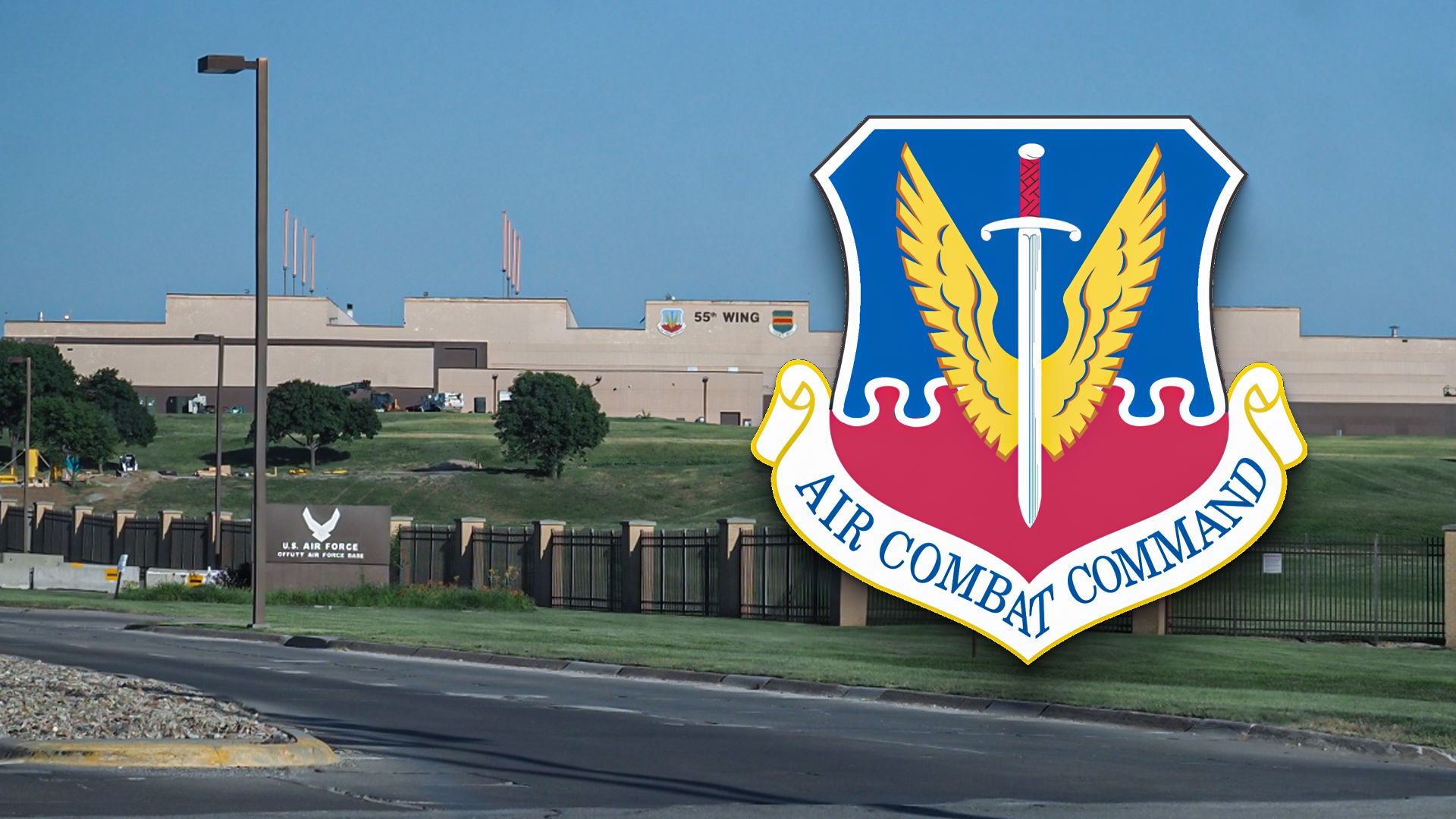Summary
- Offut AFB is home to US Strategic Command and holds a prestigious history, especially during WWII.
- The 55th Wing at Offut AFB has been responsible for continuous operations in the Central Command area since 1991.
- Today, the 55th Wing is the largest in Air Combat Command, specializing in reconnaissance and electronic attack missions.
Offut AFB (ICAO: KOFF), Nebraska – located 10 miles (16.09 km; 8.68 NM) south of Omaha and adjacent to Bellevue in Sarpy County – is arguably one of the most prestigious assignments in the United States Air Force, USAF. Part of the reason is the fact that US Strategic Command (USSTRATCOM). On 9/11, Air Force One touched down there, with then-US President George W. Bush en route back to the nation’s capital of Washington DC.
One of the individual units responsible for Offut’s prestige is the 55th Wing (55 WG), nicknamed “The Fightin’ Fifty-Fifth.” Simple Flying now looks at the Wing’s illustrious past and prestigious present.
Offut AFB early history
Offut AFB opened in September 1918 under the name Fort Crook. It was used as an Army Air Service balloon field in support of America’s WWI war effort. In 1924, the installation was officially renamed in honor of World War I pilot and Omaha native 1st Lt. Jarvis Jenness Offutt (October 26, 1894 – August 13, 1918).
Offut AFB’s proud and prestigious legacy includes the construction of the Enola Gay and Bockscar, the Boeing B-29 Superfortress that dropped the atomic bombers Little Boy and Fat Man over the Japanese cities of Hiroshima and Nagasaki in August 1945, thus finally bringing WWII to an earth-shattering halt. Offutt served for over 40 years as the HQ for the former Strategic Air Command (SAC) and the current STRATCOM.
55th Wing’s early history
Among the 55th Wing’s claims to fame is being the only USAF wing with continuous operations, maintenance, and aircraft presence in the United States Central Command area of responsibility since the 1991 Persian Gulf War (AKA Operation Desert Storm).
As per the unit’s official history page:
“The Fightin’ Fifty-Fifth has made significant contributions to the defense of our great nation for more than 50 years.”
It was established in January 1941 when the 55th Pursuit Group was activated at Hamilton Field, California. In May 1942, it was redesignated as the 55th Fighter Group and deployed to England on September 4, 1943. The 55th Fighter Group earned two Distinguished Unit Citations for its combat record during World War II.
“Assigned the mission of escorting 8th Air Force bombers on daylight bombing raids over Europe, the group completed its combat tour of duty with a distinguished record in seven campaigns. The 55th was the first operational P-38 unit in the European theater as well as the first US Army Air Force unit to fly over Berlin. With more than 600 combat missions, the group destroyed over 400 enemy aircraft while damaging more than 100. The 55th, inactivated in August 1946, had 16 aces credited with 90 victories.”
Since then, the 55th Wing has maintained a stellar record in operations worldwide, flying various aircraft.
During Operation Desert Storm – and its predecessor mission, Operation Desert Shield – the Fightin’ Fifty-Fifth furthered fortified its legendary reputation. The unit arrived in the Persian Gulf area of responsibility (AOR) on August 8, 1990. It began 24-hour-a-day reconnaissance of the region for Central Command (CENTCOM) Commander Gen. H. Norman “The Bear” Schwarzkopf (August 22, 1934 – December 27, 2012). Once the actual shooting war started in January 1991, the wing continued to provide real-time information to theater commanders and still remains there today. The 55th Strategic Reconnaissance Wing officially changed its name to the 55th Wing on September 1, 1991, to reflect its versatility in performing various missions. When SAC stood down, and Air Combat Command (ACC) was stood up, the wing transferred to ACC and gained its fifth operational location.
The 55th Wing today
The current senior leadership of the 55 WG consists of the following three top dogs:
- Col. Mark D. Howard, 55 WG Commander (AKA the “Wing King”) — earned his commission via Officer Training School (OTS) (the same venue where I earned my own commission in September 2001) at Maxwell AFB, Alabama, in July 2000; master RC-135V/W Rivet Joint Combat Systems Officer with more than 2,400 flying hours, including 940 combat and 140 combat support hours.
- Col. Aaron T. Gray, 55 WG Deputy Commander — earned his commission via Air Force Reserve Officer Training Corps (AFROTC) at Brigham Young University (BYU) in May 2002; Command Pilot with more than 3,100 flying hours, including 1,600combat hours, in the RC-135S/U/V/W, EC-130H, T-44 & T-37.
- Chief Master Sergeant (CMSgt) Andrew R. Small, 55 WG Command Chief Master Sergeant and senior enlisted adviser — enlisted in the USAF in July 1998; previous assignments include (to name just a few) Enlisted Professional Military Education (PME) developmental special duty as the Commandant of the Robert D. Gaylor Noncommissioned Officer Academy (NCOA) and Command Chief of the 557th Weather Wing at Offutt AFB.
Robert D. “Bob” Gaylor (May 8, 1930 – January 17, 2024) was the 5th Chief Master Sergeant of the Air Force (CMSAF; the highest-ranking enlisted troop in the USAF) and the first Security Policeman to hold the position. I had the honor and pleasure of meeting him at a Security Forces Dining-In at Minot AFB, North Dakota, in June 2001, when I was a mere Airman 1st Class (A1C; pay grade E-3) and a month away from reporting to OTS.
Today, the 55th is the largest wing in Air Combat Command and the second largest in the entire US Air Force. According to the base’s units info page:
“The wing’s mission is to provide dominant intelligence, surveillance, reconnaissance; electronic attack; command and control; and precision awareness to national leadership and warfighters across the spectrum of conflict any time, any place. One of the wing’s units, the 55th Operations Group, operates 46 aircraft, including 13 models of seven different types.”
The centerpiece of the 55 WG’s warbird fleet is the RC-135V/W Rivet Joint, a highly modified Boeing C-135 Stratolifter. These modifications are primarily related to its onboard sensor suite, which allows the mission crew to detect, identify, and geolocate signals throughout the electromagnetic spectrum. That mission crew can then relay the compiled information in various formats to various consumers via Rivet Joint’s extensive communications suite.
Specifications of the RC-135, as per the official Offut AFB’s official Fact Sheet on the plane, include:
- Power Plant: Four CFM International F108-CF-201 high bypass turbofan engines
- Thrust: 21,600 lbs (9,797.5 kg) each engine
- Wingspan: 131 ft (39.9 m)
- Fuselage Length: 135 ft (41.1 m)
- Height: 42 ft (12.8 m)
- Empty Weight: 173,000 pounds (78,743 kilograms)
- Maximum Takeoff Weight: 297,000 lbs (133,633 kg)
- Fuel Capacity: 130,000 lb (58,967 kg)
- Max Airspeed: 500+ miles per hour (814.9 km/h, 440 kn, Mach 0.66)
- Range: 3,900 mi (6,500 km)
- Ceiling: 50,000 feet (15,240 m)
- Crew: (flight crew) five (augmented) – three pilots, two navigators; (mission flight crew) 21-27, depending on mission requirements, minimum consisting of three electronic warfare officers, 14 intelligence operators, and four inflight/airborne maintenance technicians



